|
 Ancient Aviators:
(Evidence for Prehistoric Flight)
Ancient Aviators:
(Evidence for Prehistoric Flight)
Leonardo da Vinci was fully aware of the
potential for human flight ... but the human aspiration to fly appears
to go
much farther back into antiquity than a mere few hundred years....
A number ancient myths
and traditions record the ability of flight:
From Babylonian mythology
we have the story of Etana, who flies on a giant eagle:
'One of the earliest
preserved records of flight is in a Babylonian set of laws Halkatha,
which contains the passage: "To operate a flying machine is a great
privilege. Knowledge of flying is most ancient, a gift from the gods of old
for saving lives". The Babylonian "Epic of Etana"
describing his prehistoric flight is preserved for us in a fragmentary text
and cuneiform dating back to a period between 3,000 and 2,400 B.C.
(2).

From Greek mythology we
have the story of Daedalus and Icarus:
In Metamorphoses, the Roman
poet Ovid describes Daedalus as a highly skilled architect and the
designer of the Cretan maze. On its completion, he became homesick,
and fearing king Minos would prevent him returning, he decided to
build a flying machine.
Extract from Metamorphosis: "The
king may block my way by land or across the ocean, but the sky,
surely, is open, and that is how we shall go.....With these words,
he set his mind to sciences never explored before, and altered the
laws of nature."
He eventually completed two flying
craft, one for himself and the other for his son Icarus. It is said
that Daedalus prepared his son with the rudiments of flight, and
cast a watchful eye over him whilst in the air. They then headed out
from Crete across the Aegean Sea.
The story climaxes with Ovid's
memorable description of Icarus ignoring his fathers instructions
and soaring ever higher, till the wax of the wings began to melt and
he was "swallowed up in the deep blue waters, which are now
called after him".
Even if this particular story by
Ovid is not based on a memory of a real event, it certainly conjures
up the idea that flight was considered possible at that time.
Indian Mythology
has several prominent passages which refer to flying vehicles called
Vimana.
(Scroll down for more about Vimana)
The following images are from both Egypt and
South America.
They depict examples of what are commonly referred to as 'Zoomorphic
models'.
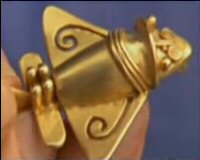 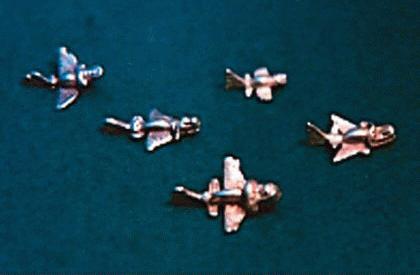
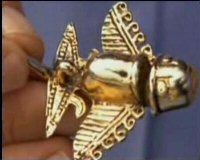
The Columbian 'planes': Considered to
be well over a thousand years old, this tiny gold object certainly has
a similar appearance to a modern aeroplane. Thought to come from a
pre-Incan culture, it measures just two inches long.
Apart from the obvious overall similarity to a
plane, the object has several interesting features. What is most
noticeable about this object is the tail-fins, never seen in nature,
but specifically placed for aerodynamics. There is also what appears
to be a 'cockpit', and it is said that the resemblance to a modern
plane was complete even to the existence of an insignia on the tail
fin which has been likened to the second letter of the Hebrew alphabet
(first of the Torah)- the letter Beth.

This particular �model� is on display in the Smithsonian Institute in
Washington DC. Its explanation states: �gold artefact, a stylised
insect, from the Quimbaya culture, Antioquia province, Columbia, ca.
1000-1500 AD.�
Elsewhere on the continent at least six very similar
artefacts were also discovered in Venezuela and Peru, and also in the
Central American state of Costa Rica (see photo above).
The Saqqara-'bird-object' -
Was discovered in a tomb near Saqqara, Egypt. It was dated at approximately
200 B.C., and was catalogued in the Cairo Museum of Antiquities as Special
Register No. 6347, Rm. 22. (2).


From Saqqara, Egypt: Dated approx. 200 BC.
(3)
We can see from the photos
above of the sycamore object, discovered during the 1898 excavation of the
Pa-di-Imen tomb at Saqqara, and in the 14 other Egyptian 'zoomorphic' models so far discovered,
that all the objects include an upright tail-fin,
a feature not seen in nature, and therefore more likely the result of
deliberate experimentation in aerodynamics ...
When a blueprint of the object was made, it was realised
that all of its highly accurate proportions were present in ratios of 2:1 or
3:1, suggesting that the model was the result of much calculation and
experimentation. Several other 'model planes' have been identified from
other tombs, bringing the total number of Egyptian gliders to fourteen
(1977)
(2).
(More about Saqqara)
A great deal of attention is given to the engravings in the temple
of Seti I, at Abydoss, Egypt.
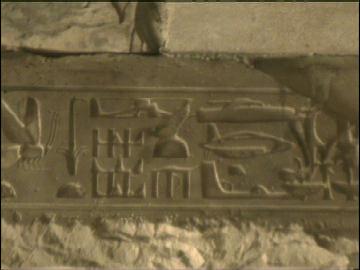
Their apparent
similarity to modern vehicles is impelling, but it has now been
reasonably demonstrated
that they are the product of two sets of hieroglyphs, one
superimposed over another... and however unusual that may seem, the idea seems borne out by
looking further along the beam... (note the Ankh in the central image).
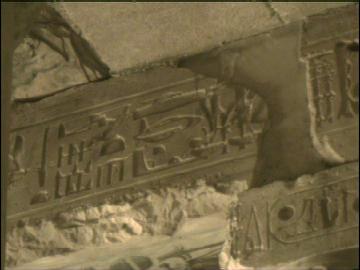
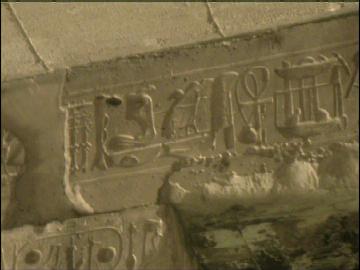
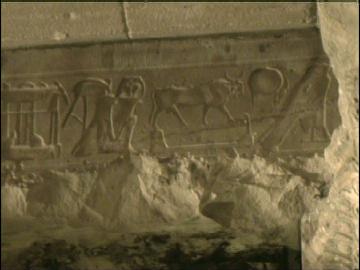
So, what we see is a
palimpsest, something that never was intended to be seen like it is
now. It used to be that only one set of hieroglyphs had been visible,
first one then the other. Then the plaster fell out of the stone.

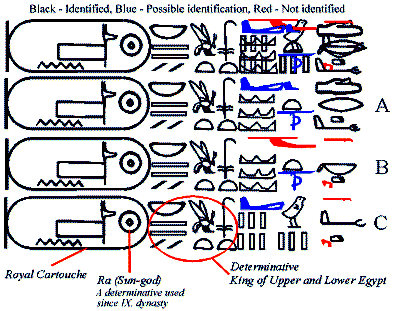
(More
about Abydoss)
The Indian sacred scriptures make
numerous references to flight. Incredibly,
the most ancient and sacred texts discuss high speed manoeuvres,
invisibility, and even a flight to the moon.
India has a particularly rich
tradition of ancient flying machines. An ancient collection of
sacred Hindu books, the Samaranga Sutradhara, contains over
200 hundred stanzas concerning almost every aspect of flying. The
International Academy of Sanskrit research conducted a special study
into this work and published its findings in a book entitled
Aeronautics, a Manuscript From the Prehistoric Past. What
emerged was a knowledge of avaiation - machines, and equipment, that
came astonishingly close to what we know today.
These ancient texts speak of the
flying machines as Vimanas. They possessed "carefully welded
joints", and were heated and driven "by controlled fire from the
iron containers..." . This sounds remarkably like modern jet powered
planes, even down to the noise that they made. This was like "the
roar of a lion", by which the whole thing was set in motion so that
"the traveller sitting inside the Vimana may travel in the
air, to such a distance as to look like a pearl in the sky"!
The Hindu
Samaranga Sutadhara
contains 230 stanzas that are devoted to flight. It describes in detail,
every possible aspect of flying. The International Academy off
Sanskrit Research in Mysore, India, conducted a study of the ancient texts
and published its findings in a book called 'Aeronautics, a manuscript
From the Prehistoric Past'. The following are a few translated excerpts
from the text:
'The
aircraft which can go by its own force like a bird - on the earth or water
or through the air - is called a Vimana.
That which can travel in the sky from place to place is called a Vimana
by the sage of old.'
'The body
must be strong and durable and built of a light wood [Lagha-daru], shaped
like a bird in flight with wings outstretched [mahavinhanga]. Within it must
be placed the mercury
engine, with its
heating apparatus made of iron underneath'.
'In the
larger craft [Daru-vimana], because it is built heavier, [alaghu], four
strong containers of mercury must be built into the interior. When these are
heated by controlled fire from the iron containers, the Vimana possesses
thunder power through the mercury. The iron engine must have properly welded
joints to be filled with mercury, and when the fire is conducted to the
upper parts, it develops power with the roar of a lion. By means of the
energy latent in mercury, the driving whirlwind
is set in motion, and the traveller sitting inside the Vimana may travel in
the air, to such a distance as to look like a pearl in the sky'.(2).
(More about Prehistoric India)
| Ancient
Chinese References to Flight: |
Chinese Mythology contains some of
the earliest references of flight:
In 1766 BC the Emperor Cheng Tang
apparently succeeded in having a flying craft built. He subsequently
ordered its destruction to prevent anyone else discovering the secret of flight.
In the 3rd century BC the Chinese
poet Chu Yun made a detailed aerial survey of the Gobi desert,
giving special praise to the durability of his craft over wind and
sand storms.
Written records of oral traditions
from Nepal also mention powered flight. They also acknowledge that
the real secrets of flight were known only to the
Yavanas.
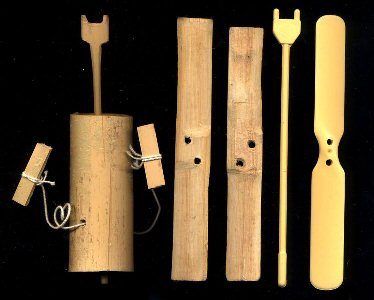
Taketonbo; The "Bamboo dragonfly") is a Chinese
children's toy invented around 400 BC
(4). It essentially consists of a
propeller on a stick, and rolling the stick in the right direction spins the
propeller, causing the toy to "take off" when it is let go of.
(More about
Prehistoric China)
|













